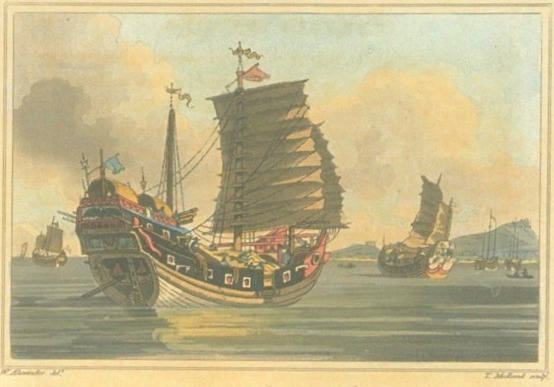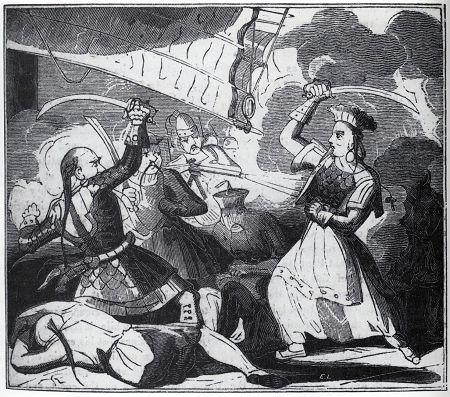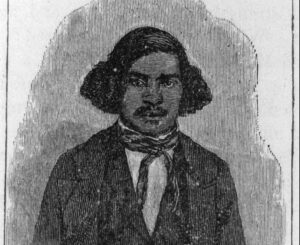In the early 1800s, Zheng Yi Sao was the terror of the South China Sea. This female warrior raided countless villages and defeated elite naval forces from Asia to Europe. Through unshakeable determination and brilliant strategy, she created the world’s greatest and largest pirate confederation.
Beginnings
Zheng Yi Sao’s beginnings are a bit murky. Most likely, she hailed from rough beginnings in a poor family. Her name was originally Shi Xianggu. Some sources claim she was one of the Tanka, an ethnic group occupying Shanghai, Macau, Hong Kong and other areas. They were known for living on Chinese junks parked on a river or in a bay. It is possible that she was a prostitute or madame of a brothel in one of the junks.

1804 painting of a Chinese junk. Photo: Unknown
Marriage
During this time, she met her first husband Zheng Yi, who turned out to be a pirate from a long line of seafaring criminals terrorizing South China. After marrying him, she changed her name to Zheng Yi Sao, which means “Zheng Yi’s wife.” The couple had two sons.
His family members had large fleets of ships that raided towns and vessels and fought against government naval forces. Zheng Yi was originally a privateer for the Vietnamese dynasty Tây Sơn before he had other ambitions in mind. His cousin, another pirate leader, died, allowing him to take leadership of his large fleet. This gave them an idea. After he and Zheng Yi Sao got married, they began building one of the world’s greatest pirate empires.
A pirate confederation
In this period, piracy was a lucrative business and very successful in evading and defeating naval forces. Many became pirates to escape poverty. Some simply wanted power. However, some individuals were pirates by coercion and all these walks of life were part of Zheng Yi Sao’s operation. Other than raiding, the confederation provided paid protection and offered mercenary services.
They absorbed other fleets, not by force but by another method. In order to foster cooperation and a lack of rivalry, Zheng Yi Sao and her husband convinced the fleets’ leaders to form a confederation, and they agreed to give up some of their autonomy for the good of all. Each fleet would have relatively the same amount of money and resources, they would have each other’s backs in conflicts, and live by important codes.
These conditions made them an incredible and united fighting force. Six fleets signed the agreement. They were named after the color of their flags -– red, black, purple, white, and yellow. Red was the largest of them all. By the time this was done, Zheng Yi Sao and Zheng Yi managed over 60,000 or 70,000 pirates.
Zheng Yi Sao was quite adept at negotiation and organization. Sociologist Joseph MacKay stated that Zheng Yi Sao “substantially reformed and formalized the gang’s administrative structure, imposing complex systems for dispute resolution and division of acquired wealth.”
Essentially, she was the brains behind the operation while her husband was the leader and brute force.
The confederation took on major powers including the East India Company, the Chinese government, and the Portuguese. Even the British got involved. These forces often underestimated the pirates. Their organization was extremely efficient. The confederacy ran parallel to the system structure of the Qing Dynasty.
Rise to power
Zheng Yi Sao ended up taking over the entire fleet when her husband fell overboard to his death. Despite her widowhood, she carried on with pirate affairs…and other personal affairs. She entered a relationship with her husband’s adopted son, Zhang Bao. This led to speculation that they were fraternizing behind Zheng Yi’s back when he was still alive. Her relationship with Zhang Bao and the support of other pirate leaders were instrumental in her rise to power.
Conventions for Chinese women were the total opposite in the realm of piracy. When you would think that men would have rejected her after Zheng Yi died, they greatly respected and followed her rule. In fact, because of their loyalty and Zheng Yi Sao’s strategic mind, the confederacy went further than ever. Her leadership brought South China to its knees.
Members of the confederation had to follow several rules or they would be executed by decapitation. A pirate could not go onshore without permission, steal from another pirate, or rape or harass of women. All these transgressions were punishable by death. Zheng Yi Sao was particularly strict about protecting women, probably because of her past as a prostitute.

A pirate battle. Illustration: Unknown
Zheng Yi Sao did not create these rules, but after her husband died, she wrote several more commandments to build on his. She decreed that no one else but her and a few other superiors would give commands. There was no stealing from villagers who helped them, no withholding loot, and plunder was redistributed fairly among the fleet. Finally, only she could approve raids. During their raids of Shunde, Donguan, Xinhui, and Guangdong, over 12,000 people died.
Battling the Portuguese and Chinese
Eventually, the Chinese allied with the Portuguese in an attempt to cripple the pirate fleet. They set up blockades, engaged in skirmishes, and sent fireships to burn them in the water. The Portuguese wanted payback after the pirates defeated them in some early battles. The attempted blockade did not last long, though. Zheng Yi Sao was also a brilliant tactician and managed to break blockades and turn their enemies’ fireships back on themselves.
Surrender and retirement
Brilliantly, Zheng Yi Sao saw a perfect opportunity to get off scot-free. She officially surrendered in 1810 and in exchange, she was allowed to retire without consequences. As far as the citizens of South China were concerned, they simply wanted to stop the piracy. Her negotiation skills helped her and her fellow pirates in their amnesty deals.
Usually, pirates do not see a happy ending. But Zheng Yi Sao did. This did not mean that she gave up the pirate life for good. She opened up a gambling house and earned a fortune. She passed away at 69.
Legacy
Feminist groups claim Zheng Yi Sao as a hero and a woman who beat all odds. She made it quite far in her time, especially after her husband died. She is even hailed as the greatest pirate in all history. Take that, Blackbeard!
Her legacy lives on extensively in graphic novels, books, TV shows, musicals, and movies. Do you remember Mistress Ching from Pirates of the Caribbean: At World’s End? Yes, that was inspired by Zheng Yi Sao.
In 2020, an Australian climber named Angela Eiter was the first woman to ascend a route she named Madame Ching in Imst, Austria in honor of the famed pirate. She said “…the most dangerous female pirate in history and a perfect name for my possible hardest first ascent to date!”

Angela Eiter ascending Madame Ching. Photo: Angela Eiter/Instagram






